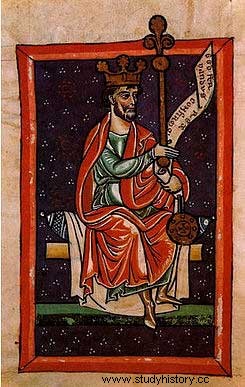Ferdinand I (the Great), King of León (1037-1065) and Count of Castile. Second son of Sancho Garcés III (King of Navarre) and his wife Mayor of him or Nuña (sister of the Count of Castile, García Sánchez). Fernando I took the title of king of Castile when he married Sancha (sister of Bermudo III, king of Asturias and León) in 1032, when his father gave him the county of Castile and the lands between Pisuerga and Cea, with the kingdom designation. When Bermudo III died without issue in 1037, his kingdom passed to his sister Sancha de el; reason why this kingdom was united to that of her husband; this, therefore, became king of Castile and León from that date , and he was crowned King of León, in this same city, in the church of Santa María, by Bishop Servando in 1038.
Expansion to navarra
This union of the two kingdoms was very important for Fernando I in the fight against al-Andalus. Due to rivalries with his brother García Sánchez III (King of Navarre) the two were at odds and, on a visit that García Sánchez III made to Fernando I, he locked him up in the castle of Cea; but the Navarrese escaped and, together with the Muslims, came against Burgos; Fernando I went out to meet him and the fierce battle of Atapuerca, near Burgos, was fought, in which García Sánchez III died in 1054 . Then, Fernando I, taking a part of the kingdom of Navarre, extended his dominions to the right bank of the Ebro river, leaving the rest of the Navarrese kingdom for his nephew Sancho Garcés IV (son of his brother of he Garcia Sanchez III).
Taifas conquests

In 1055, Ferdinand campaigned against the Taifa of Badajoz, from which he seized, within three years, Viseo, Lamego and several castles. On July 24, 1064, he seized Coimbra. He also took the war to the Taifa of Zaragoza, which he conquered Vado del Tey, Berlanga, Aguilera, San Esteban de Gormaz and several castles, and subjected them to vassalage. he Later he went against the taifa of Toledo and seized Uceda, Salamanca, Guadalajara, Alcalá de Henares and Majerit; the régulo of Toledo, al-Mamun, asked for peace; Ferdinand I granted it to him under promise of vassalage . Given these events, Motadid de Sevilla went to meet Fernando I and asked him to make a peace treaty; the Castilian granted it in exchange for an annual tribute and the return of the remains of Saint Isidore, which the Muslim complied with.
Deathandrepartitionofkingdoms
In 1064, he laid siege to the city of Valencia; but, the following year, falling ill, he went to Leon, where he arrived on December 24, 1065, and died three days later. he had distributed his kingdom, which comprised a third of the Iberian Peninsula, among the five children of his with his wife Sancha, which had been accepted by a board of nobles from Castile and Leon . According to this distribution, his eldest son Sancho left him Castile; to his second son, Alfonso, León and Asturias; to his third son, García, Galicia and the conquered territory in Lusitania up to the Mondego river; to his daughter Elvira, he left the city of Toro; and, to his daughter Urraca, that of Zamora; both dependent cities of León; but this situation was only maintained during the three years that Queen Sancha lived.
Coyanza Council
Ferdinand I ordered the celebration of Sundays, in accordance with what was agreed at the Council of Coyanza (now Valencia de Don Juan) in 1050. In the 3rd canon, it is ordered that clerics “have no other woman in their house than his mother, sister, aunt or stepmother, who must dress in a single color and decent” . The 6th canon prohibits Catholics from “living and eating with Jews, marking severe penalties for those who break this law” . We see that celibacy, which began to germinate in the Council of Elvira in the year 306, is already reaching its apogee here; while, in this Council, the Catholic religious unity of the Iberian Peninsula begins to germinate, previously carried out by Recaredo, broken by Islam, and which will be carried out again when the Catholic Monarchs arrive.
